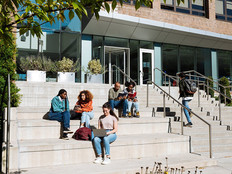Telemedicine Makes an Impact on Higher Ed Student Healthcare
When college students get sick, traditionally, they’ve had to trek to their university health center or a local doctor’s office for an exam. Today, however, technology is providing another option through telemedicine, which allows patients to receive care via chat or email.
Virtual treatment appears to be a growing practice; more than half (56 percent) of health executives say their organization has already implemented telemedicine technology, according to a recent survey. Of healthcare leaders who have yet to implement, 86 percent rate it as either a medium or high priority.
SIGN UP: Get more news from the EdTech newsletter in your inbox every two weeks!
Telemedicine Expands Student Access to Care
Tech-centric care is currently being offered at a number of colleges and universities, including the University of Washington Tacoma, which debuted a telemedicine option in July 2017. The university hopes this initiative will help increase the number of UW Tacoma students who benefit from its on-campus clinic, which is currently 30 percent.
To provide healthcare to students when its on-site facility is closed, the University of California, Berkeley, partnered with an external telemedicine provider to offer remote access to board-certified medical professionals via phone, tablet or computer from 5 p.m. to 8 a.m. during the week and on weekends. Students can confer with physicians about the flu, a cold or a variety of other ailments.
Telemedicine Adoption Is Promising, but Not Perfect
The technology can pose some challenges. Certain conditions could be difficult to diagnose remotely, and without an in-person exam, misdiagnosis is possible. Confidentiality issues can also be a concern, for example, if someone were to walk into a patient’s room without warning during a telemedicine session or overhear something from outside the room.
Despite this, telemedicine can also offer a number of advantages. Convenience is certainly a big plus for many care recipients — particularly at large campuses where the health center may be located far from where a student lives.
Telemedicine may also be able to help student health centers that are facing increased care needs.
Although the Affordable Care Act has helped reduce the number of uninsured college students, nearly 1.7 million still don't have coverage, making them the largest uninsured group in the U.S., according to a recent study. This makes students likely to utilize university-provided health services, which are often cheaper than other care options.
According to Urban Institute research, the ACA has generally increased the number of Americans who have health insurance. Subsequently, in some areas, local medical providers could be seeing a greater demand for services. Telemedicine initiatives would make it easier for students with private insurance to visit their school’s health center if they couldn’t get an appointment with an off-campus provider.
Some institutions, such as the University of Southern Mississippi, which began offering telemedicine services in 2015, have been able to successfully serve more patients by using the technology.
At Southern Miss’s Gulf Park campus, a nurse is responsible for initiating the webcam connection with a physician located at the school’s main campus in Hattiesburg, Miss. In addition to being able to see and speak with the student, the doctor can use information sent from networked otoscopes and stethoscopes on the telehealth unit to form a diagnosis and determine the best course of treatment.
Previously, the Gulf Park campus was only able to offer health and wellness services one day a week. Since instituting a telemedicine option, it has been able to significantly expand its care, increasing students’ access to medical services to four days a week.









